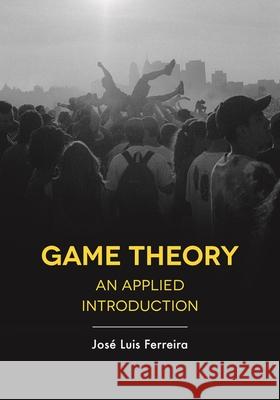Game Theory: An Applied Introduction » książka



Game Theory: An Applied Introduction
ISBN-13: 9781352007916 / Angielski / Miękka / 2019 / 293 str.
Game Theory: An Applied Introduction
ISBN-13: 9781352007916 / Angielski / Miękka / 2019 / 293 str.
(netto: 268,35 VAT: 5%)
Najniższa cena z 30 dni: 272,62
ok. 30 dni roboczych.
Darmowa dostawa!
Chapter 1. The most famous games.- 1.1 The coordination game.- 1.2 Choice of standards.- 1.3 The battle of the sexes.- 1.4 The chicken game.- 1.5 The prisoners’ dilemma.- 1.6 Matching pennies.- 1.7 The ultimatum game.- Chapter 2. Building the theory for simultaneous games.- 2.1 The normal form game.- 2.2 Towards a solution.- 2.3 Some propositions on maximin strategies, rationalizable strategies and Nash equilibria.- 2.4 Finding the Nash equilibria.- 2.5 Complications in finding the Nash equilibria.- 2.6 The payoffs of the game and the mixed strategies.- Chapter 3. Static games.- 3.1 Fiscal battles.- 3.2 The median voter.- 3.3 The advantage of being indifferent.- 3.4 The broken windows theory.- 3.5 The independence of Sylvania.- 3.6 Cournot oligopoly.- 3.7 Bertrand oligopoly.- 3.8 Keeping up with the Joneses.- Chapter 4. Dynamic games.- 4.1 The extensive form. Backwards induction.- 4.2 The prisoners’ dilemma with a previous contract.- 4.3 Subgame perfect Nash equilibrium.- 4.4 How to be credible (1): Elimination of strategies. Odysseus and the sirens.- 4.5 How to be credible (2): Acquire costly compromises. Who enters?.- 4.6 How to be credible (3): Give up control. Separation of powers.- 4.7 The consequences of not being credible. The health care game.- 4.8 The payment of the debt.- Chapter 5. Voting.- 5.1 Sincere and strategic voting.- 5.2 The manipulation of the agenda.- 5.3 Condorcet’s paradox.- 5.4 Referendum with minimum participation.- 5.5 The Borda count.- 5.6 Arrow’s theorem.- 5.7 The theorems by Gibbard–Satterthwaite and May.- 5.8 The median voter theorem.- 5.9 I'll scratch your back and you'll scratch mine.- 5.10 How to know the truth. The Groves-Clarke’s mechanism.- 5.11 Do we know what do the people want?.- 5.12 The discursive dilemma.- 5.13 A referendum in Catalonia.- Chapter 6. Negotiation games.- 6.1 The model of offers and counteroffers.- 6.2 Impatience.- 6.3 Risk aversion.- 6.4 Negotiating with fanatics.- 6.5 Some discussion.- 6.6 An actual case: the hijacking of the Alakrana.- 6.7 The Coase theorem.- 6.8 When not to apply the Coase theorem.- Chapter 7. Repeated games.- 7.1 The Christmas truce.- 7.2 A game repeated twice.- 7.3 Cooperation in the infinite and indefinite repetitions.- 7.4 Some technical details.- 7.5 Other strategies in the repeated game.- 7.6 The cooperation in the prisoners’ dilemma repeated finitely many times.- 7.7 What experiments say.- 7.8 What the empirical data say.- 7.9 Altruism, reciprocity and evolution.- 7.10 Not a zero-sum game.- 7.11 Axelrod’s tournament.- Chapter 8. Agency problems: adverse selection.- 8.1 The agency problem.- 8.2 The information sets.- 8.3 If you didn’t have anything to hide you’d show me your e-mails.- 8.4 Adverse selection in a first agency problem.- 8.5 Adverse selection and public health systems.- 8.6 Other examples of adverse selection.- 8.7 Other types of adverse selection.- 8.8 Competition reveals information: When the principal has information about the agent.- 8.9 On Rawls’ original position and the ex-ante criterion.- Chapter 9. Agency problems: signaling and moral hazard.- 9.1 Signaling with a discrete variable.- 9.2 The empirical evidence of education as a signal.- 9.3 Signaling with a continuous variable and discrimination in the labor market.- 9.4 Moral hazard: Fixed payment or payment by performance?.- 9.5 Moral hazard: Copayment, yes or no?.- 9.6 Moral hazard: Work with teams and cooperatives.- Chapter 10. Seven applications of Game Theory.- 10.1 The battle of the Bismarck Sea.- 10.2 The nuclear war.- 10.3 You cannot use information without revealing it.- 10.4 You should bluff from time to time.- 10.5 There may not be weapons of mass destruction: should we still attack?.- 10.6 Is free trade a prisoners’ dilemma?.- 10.7 Negotiations between Greece and the Troika.- Chapter 11. Seven more applications.- 11.1 The minority language.- 11.2 Pascal’s Wager.- 11.3 The surprise exam paradox.- 11.4 The sentence as deterrence.- 11.5 Solidarity versus charity.- 11.6 Single round versus runoff elections.- 11.7 How to end with infractions.- Chapter 12. Dynamics.- 12.1 Evolutionary dynamics: The hawk-dove game.- 12.2 Imitation dynamics: A segregation model.- 12.3 Best-reply dynamics: The emergence of language.- 12.4 No weakly dominated strategies dynamics: Self-inflicted injuries.- 12.5 Adaptive dynamics: Voluntary contribution to the provision of public goods.- Chapter 13. Limited rationality and behavioral economics.- 13.1 Preferences changing with time: which ones deserve priority?.- 13.2 Time inconsistency and energy saving.- 13.3 Irrationality due to the complexity of the election.- 13.4 Irrationality due to overconfidence.- 13.5 The age of majority.- 13.6 Indoctrination.- 13.7 Nudging: when to let others influence you.- 13.8 On other irrationalities that are not so irrational.- 13.9 Towards a behavioral theory.- Chapter 14. Power indices.- 14.1 Cooperative and majority games.- 14.2 Power indices in majority games.- 14.3 Application of power indices to three parliaments.- 14.4 Games with many quotas.- 14.5 The distribution of power in the EU after Brexit.- 14.6 Power indices with abstention.
1997-2026 DolnySlask.com Agencja Internetowa
KrainaKsiazek.PL - Księgarnia Internetowa









